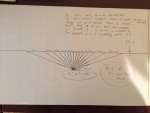Hey guys,
I had a question, not really a homework assignment but more of a just wondering question. Please look at my photo of the drawing that I drew to scale on graph paper. So my question is if you have a laser that is lets say 50 units from the plane, and you move it exactly 10 degrees (i chose 10 just for the **** of it) is there any way to calculate the distance the laser moves on the plane. I know that the distance between the laser and the plane increases,which increases the distance on the plane, however I was wondering if there is any formula or percentage that you can calculate the distance of space being used with a set increment of degrees. I tried measuring the distance out in mm as close as I could and could not recognize any pattern or set fractions.
 Please look at my drawing, thanks again everyone and happy Friday
Please look at my drawing, thanks again everyone and happy Friday
I had a question, not really a homework assignment but more of a just wondering question. Please look at my photo of the drawing that I drew to scale on graph paper. So my question is if you have a laser that is lets say 50 units from the plane, and you move it exactly 10 degrees (i chose 10 just for the **** of it) is there any way to calculate the distance the laser moves on the plane. I know that the distance between the laser and the plane increases,which increases the distance on the plane, however I was wondering if there is any formula or percentage that you can calculate the distance of space being used with a set increment of degrees. I tried measuring the distance out in mm as close as I could and could not recognize any pattern or set fractions.

